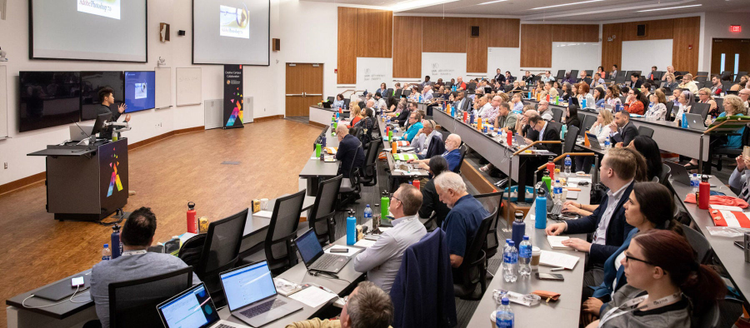Prescribing Digital Literacy for Medical Professionals with Adobe Creative Cloud

People are increasingly turning to digital sources for news, entertainment, and communication. According to Nielsen, adults in the United States spend nearly four hours a day interacting with apps, web, and internet-connected devices. Understanding how to navigate the digital landscape has become critical for many industries. Future doctor Vincent Fu believes that healthcare is the next industry that must learn to embrace digital as a way to communicate with patients.
Fu, a University of Utah graduate, learned early in his college education how digital literacy can help educate and communicate with audiences. He is helping to change the digital paradigm for doctors at the University of Colorado, where he is working toward his MD and teaching a new online course in digital and social media.
“Digital and social media are an ever-growing part of our world, and to send physicians into practice without some level of digital literacy – or worse yet, to advise them to avoid public engagement over social channels – would be irresponsible,” says Fu, a 25 year-old Denver resident. “So, I’ve been speaking about the need for digital literacy at various campuses. And last year, I partnered with Dr. Matthew Zuckerman from the University of Colorado School of Medicine on an elective course, Digital MD, built around Adobe Creative Cloud, to teach medical students how to use digital and social media in their future practices.”

Simplifying complex medical concepts
Fu says many healthcare providers today shun the idea of being active in social media because they think it’s not for them or suitable for the discipline of medicine. But he notes those individuals are missing out on an opportunity to build personal brands that might drive their practices to new heights. More importantly, Fu says they are also overlooking the significant potential digital and social media technology offer for communicating with patients more effectively and consistently.
“Our entire course is built around the idea that creativity can play a central role in how you practice medicine,” Fu says. “Throughout my collegiate career, digital technologies helped me communicate in ways that I typically would not have considered as a scientist. They enabled the articulation of very complex scientific concepts in understandable and digestible ways to the public.”
Fu first experienced the importance of digital literacy during a research symposium at the University of Utah. He and other undergraduate biology students were tasked with presenting the results of their laboratory thesis project. Rather than using the poster template in PowerPoint provided by the College of Science, Fu prepared his scientific research poster about “Laminins as a Potential Enhancer of Beta Cells” using Adobe Illustrator.
“I knew that, in order to really produce something that people could just glance at to understand my research and conclusions, I needed to take a graphic-centered approach rather than writing the typical wall of text,” he says. “Adobe Illustrator enabled me to apply visual thinking to science in an attractive scientific format.”
The connection between digital literacy, communication, and science became even more apparent at Fu’s first job after graduation. Before moving on to medical school, Fu decided to join the workforce and gain real-life experience. His biology background and the creative skills learned through Adobe Creative Cloud helped Fu land a job at ProLung, a new and growing medical device company. Hired as a front-end app developer, Fu quickly transitioned to the marketing team where he developed all of the marketing communication assets for the company.
“Medical concepts can be challenging to explain,” says Fu. “My skills in visual media make a world of difference in communicating content and research data in a visually consistent way.”

https://theblog.adobe.com/wp-content/uploads/2020/03/URS-Poster-PNG-012.png
Improving patient satisfaction – creatively
Fu says practicing medical professionals could and should be thinking about how they can communicate complex topics in a creative and visual way. Often, doctors have hurried conversations with patients about their medical conditions or treatment options. These frequently involve heavy doses of technical terms that are difficult to comprehend.
By using the various tools found in Adobe Creative Cloud, Fu says healthcare providers can greatly simplify this information exchange while also improving overall patient satisfaction. In fact, research indicates applying digital information technology can improve the quality of healthcare.
“We must shift the mindset behind information sharing from being exclusively data-driven and scientific to something that is more palatable for most patients,” Fu says. “Healthcare professionals today need to acquire digital literacy competencies to interact with people more personally and meaningfully.”
Fu adds that healthcare professionals do not have to limit sharing what they produce with Adobe Creative Cloud to office visits or lobby walls. They can also replicate them digitally across key social media sites to share their expertise and thoughts on important medical topics.
“A lot of physicians have jumped onto Twitter to bring the truth of their working experience to various discussions they see under way,” Fu says. “In my class, I underscore the point that you can use Adobe Creative Cloud apps to create visuals, presentations, and videos to more powerfully disseminate your educated points of view in those online communities.”
Fu adds that digital literacy and social media should go hand-in-hand for healthcare professionals because they are so complementary to one another.
“Adobe Creative Cloud is really a perfect bridge for those two technologies as all the apps provide a great way to not only create compelling content, but also to share it dynamically for public engagement,” he says.
To learn more about how your institution can help students succeed with the soft skills needed for the modern economy, please visit here.